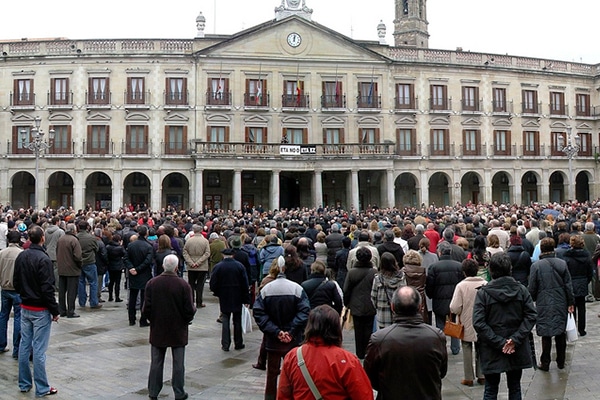
It has been a long time coming, but finally the Basque separatist group ETA has dissolved itself, ending one of the longest terrorism campaigns in modern Europe with the loss of 854 lives, thousands injured and 79 kidnappings. The move, however, is far from healing the deep wounds among the victims’ families.
Founded in 1959 during the Franco dictatorship, initially as a cultural organisation and later as an armed group to fight for an independent Basque state, ETA’s highest profile killing was the 1973 bombing of the car in which the dictator’s presumed successor, Prime Minister Luis Carrero Blanco, was travelling.
ETA stepped up its campaign after the advent of democracy as of 1975, which was sealed by the 1978 Constitution. It killed 95 people in 1980 –twice as many as during the Franco regime. The scale of the killings led Spain’s security apparatus to set up death squads that hunted down and killed 27 ETA suspects. ETA’s legitimacy was boosted by this ‘dirty war’, which seriously undermined the rule of law.
ETA whose initials stand for Euskadi Ta Askatasuna or ‘Basque Country and Freedom’, regarded the considerable degree of autonomy granted to the Basque Country after 1978 in matters of social security, tax, education and police, as a cosmetic change in the authoritarian nature of the Spanish state. The group still regarded the state as an occupying force. In its bloodiest single attack in 1987, 21 people died when it placed bombs in the parking lot of a shopping centre in Barcelona (see Figure 1).
Figure 1. Selective timeline on ETA, 1958-2018
| 1959 | ETA created during the Franco dictatorship to fight for an independent Basque Country |
| 1968 | Kills Civil Guard officer in its first deadly attack. |
| 1973 | Franco’s prime minister, Admiral Luis Carrero Blanco, killed when a bomb is detonated under his car. |
| 1974 | Thirteen people die in a bomb attack on a Madrid café. |
| 1980 | The bloodiest year of its violent campaign, two years after Spaniards approve a new democratic constitution: 92 people killed. |
| 1987 | Single bloodiest attack: 21 people killed by bombs in the parking lot of a shopping centre in Barcelona. |
| 1989 | ETA declares its first cease-fire but breaks it by killing a Civil Guard officer. |
| 1996 | Francisco Tomás y Valiente, former president of the Constitutional Court, killed. |
| 1997 | Six million people took to the streets to protest at the murder of Miguel Ángel Blanco, a local Popular Party politician. |
| 1998 | New ETA truce ends in 1999 after failed negotiations. |
| 2002 | New law on political parties bans Batasuna, an ally of ETA. |
| 2006 | Third cease-fire ends after car bomb kills two Ecuadorians in Madrid airport parking lot. |
| 2011 | ETA announces ‘definitive cease’ to its armed struggle. Officials say ETA believed to have fewer than 50 members. |
| 2017 | ETA disarms after handing over weapons to French authorities. |
| 2018 | ETA dissolves itself. |
Weakened by repeated arrests of leaders and operatives and minimal support for its cause in the Basque Country, the group became a spent force some years ago. Its dissolution was inevitable. Yet only now has it disbanded. The last person killed in Spain was in 2009 and in France in 2010.
ETA said in a statement announcing its dissolution that a ‘lack of will to solve the conflict’ had prolonged it, and ‘multiplied the suffering.’ The Popular Party government, in power since November 2011, was always adamant, as were Socialist governments, that it would make no concessions to end the conflict including now that ETA has dissolved itself.
ETA ‘didn’t get anything for stopping to kill [it declared a cease-fire in 2011] and will not get anything for declaring its disappearance,’ said Juan Ignacio Zoido, Spain’s Interior Minister.
The government said there would be no impunity, unlike in Northern Ireland following the 1998 Good Friday Agreement, and vowed to continue its criminal investigations. According to Covite, an association of victims, at least 358 ETA crimes have yet to be resolved.
In the Northern Ireland conflict, so-called ‘comfort’ letters were introduced as a way of dealing with on-the-run IRA suspects who had not been imprisoned for terrorist offences and released as part of the agreement. The legality of these letters has since been questioned.
The one area where there might be some leeway is on the location of the 243 ETA members serving jail sentences in Spain (another 53 are in France). Government policy has been to keep most of them far from their families. Some of them might be moved to prisons nearer to the Basque Country.
ETA has only apologized to victims who did not have a direct participation in what it calls the ‘conflict’, implying that members of the security forces were legitimate targets. This has outraged the families of victims. A total of 443 civil guards and police, 58 businesspeople and 39 politicians died at ETA’s hands, according to Europa Press news agency.
‘This is not the end of we wanted as a society or as victims, and not the one we deserved’, said Consuelo Ordóñez, the head of Covite, whose brother Gregorio, a Popular Party politician, was killed by ETA in 1995.
ETA said its decision ‘ends ETA’s 60-year historical cycle. But it does not bring an end to the conflict between the Basque homeland and Spain and France. The conflict did not begin with ETA and will not end with its dissolution.’
ETA’s cause will now be channeled politically. Support for an independent Basque state, which would include parts of southwestern France near the Spanish border, is no more than 14%, according to a poll last November by the University of Deusto, far from that in Catalonia.
ETA’s twisted narrative is at odds with that of democrats of all political persuasions. The group might had some sympathy during the Franco regime, but had no reason to exist once it became clear that Spain was set on a path of democracy.
Jorge Semprún, a former communist opponent of the Franco regime and Culture Minister (1988-91), called ETA ‘the only serious residue that remains of Francoism.’ In this sense, it can be said that Francoism has finally been defeated.


